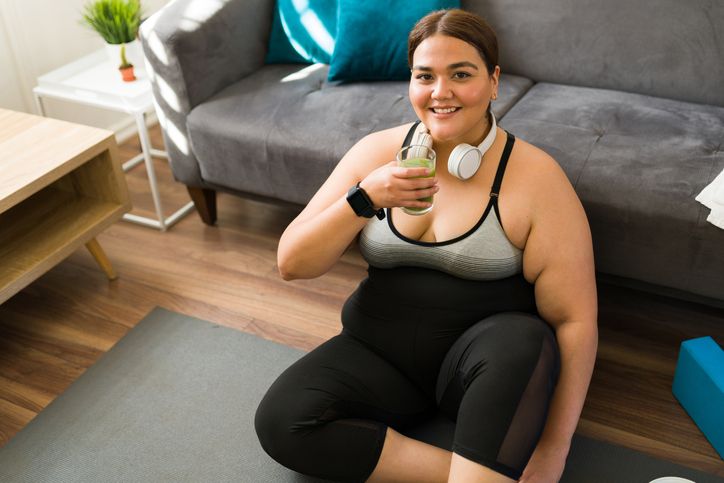
作者: Puteri Fikri|更新:2024年1月2日
Reducing weight can be a difficult task, especially if you don't know where to begin. You may feel overwhelmed by the sheer volume of weight loss material accessible, from fad diets to contradicting advice on workout programs. Taking the initial step toward a healthier lifestyle, on the other hand, is a significant decision that can have long-term benefits for your physical and mental well-being. If you want to lose weight but don't know where to begin, it's vital to realize that you're not alone. Many people battle with weight reduction, and it is acceptable to seek assistance and support in order to reach your goals.
1
What you should do to start your weight loss journey

When it comes to losing weight, there are a few key considerations that can make or break long-term success. Here are some things to think about when you first start out:
Set realistic goals: Setting realistic goals is one of the most important things to consider when beginning a weight loss journey. It's important to remember that losing weight takes time and effort, and it won't happen overnight. Setting small, attainable goals can assist you in staying motivated and tracking your progress over time.
Make a plan: Creating a plan is essential for weight loss success. This includes meal planning, exercise scheduling, and tracking your progress. A plan can help you stay on track and avoid common pitfalls such as skipping workouts or eating unhealthy foods.
Focus on developing healthy habits: Rather than focusing solely on losing weight, it is critical to focus on developing healthy habits that you can maintain in the long run. Making healthier food choices, incorporating regular exercise into your routine, and getting enough sleep are all examples of these top five healthy habits.
Seek help: Losing weight can be difficult, and having a support system in place can help you stay motivated and accountable. It could be a friend, a family member, or a support group.
Finally, it is critical to be patient with yourself. Losing weight is a process, and setbacks are normal along the way. Instead of giving up, use setbacks to learn and adjust your strategy as needed. You can achieve your weight loss goals and live a healthier, happier life if you are persistent and patient.
2
Type of diet you can try

Keto diet
The keto diet, often known as the ketogenic diet, is a popular low-carbohydrate, high-fat diet in recent years. This diet entails substantially reducing your carbohydrate intake and substituting it with healthy fats, which induces ketosis in your body. These are some facts about the keto diet:
The keto diet emphasizes high-fat, low-carbohydrate foods including meats, fish, eggs, dairy, nuts, and healthy oils like coconut and olive oil. Because starchy vegetables, cereals, sweet foods, and most fruits are heavy in carbs, you should avoid them.
The keto diet has been demonstrated to be helpful for weight loss, as well as for improving blood sugar control, lowering inflammation, and even increasing brain function. Some people experience higher energy and better sleep quality.
It requires a large reduction in carbohydrate intake, the keto diet can be difficult to follow. This can result in "keto flu" symptoms such as headaches, lethargy, and constipation. It's also worth noting that the keto diet may not be suitable for everyone, especially individuals with certain medical issues such as liver illness or pancreatitis.
The keto diet may be appropriate for people who want to lose weight, improve blood sugar control, or manage specific medical disorders such as epilepsy. But, before beginning this diet, it's crucial to contact a healthcare practitioner to confirm it's safe and appropriate for your unique circumstances.
Low calorie diet
A low calorie diet is a sort of weight loss regimen in which you limit the quantity of calories you consume per day. A low calorie diet often restricts your daily calorie intake to 1200-1500 calories, which is much less than the usual daily intake for individuals. This diet often consists of low-calorie items such as vegetables, fruits, lean protein sources, and other whole foods and grains.
The main advantage of a low-calorie diet is weight loss. Consuming less calories than your body burns results in a calorie deficit, which contributes to weight reduction. A low-calorie diet may result in greater insulin sensitivity, lower blood pressure, and a lower risk of chronic diseases such as heart disease, diabetes, and certain types of cancer, in addition to weight loss.
One disadvantage of a low-calorie diet is that it can be difficult to maintain. Calorie restriction might leave you feeling hungry and deprived, which can lead to binge eating or abandoning the plan entirely. Furthermore, if the diet is too low in calories, it might lead to vitamin shortages, which can be harmful to your health.
A low calorie diet is appropriate for persons who want to reduce weight and do not have any underlying health concerns that would make it harmful. Nevertheless, before beginning any new diet or weight loss program, consult with your doctor or a trained dietitian to ensure that it is safe and appropriate for your specific requirements and goals. Moreover, physical exercise should be included in your own weight management or loss plan to maximize the health advantages and maintain long-term weight loss success.
Atkins diet
The Atkins diet is a low-carbohydrate and high-protein diet that promotes weight loss while also improving general health. The diet is based on the premise that eating less carbohydrate and more protein can help control appetite, stabilize blood sugar levels, and boost fat burning. The Atkins diet primarily consists of foods strong in protein and healthy fats, with carbohydrate intake limited.
The main advantage of the Atkins diet is of course, weight loss. The diet's high protein content can aid in the reduction of hunger and cravings, while the low carbohydrate content eat healthy food can aid in the stabilization of blood sugar levels and the promotion of fat burning. Aside from weight loss, the Atkins diet has been linked to various health benefits such as improved blood lipid profiles, lower inflammation, and better diabetic control.
One disadvantage of the Atkins diet is that it can be tough to stick to, especially in the long run. Many high-carbohydrate items are restricted in the diet, which can be difficult for some people to maintain over time.
Furthermore, the diet may be heavy in saturated fats, which, if consumed in excess, might increase the risk of heart disease. To reduce the danger of negative health impacts, it is critical to choose good sources of protein and fat while following the Atkins diet.
The Atkins diet is appropriate for persons who want to lose weight while also improving their overall health. However, it may not be suitable for people who have specific medical issues, such as renal or liver disease.
Before beginning any new diet or weight reduction program, consult with your doctor or a certified dietitian to ensure that it is safe and appropriate for your specific requirements and goals. In order to maximize the health benefits and maintain long-term weight loss success, it is also critical to incorporate physical exercise into your own weight loss diet and plan.
Incorporate exercise habits into your daily routine
Exercise can be an effective weight-loss method since it helps to burn calories, enhance metabolism, and build lean muscle mass. Exercise, when combined with a good and healthy diet too, can help people reach and maintain a healthy weight, as well as enhance overall health and wellbeing.
There are various sorts of exercise that can help you lose weight, including:
Cardiovascular exercise, such as jogging, cycling, or swimming, is an excellent way to burn calories and raise heart rate. When done at a moderate to high intensity for at least 30 minutes every session, this sort of exercise can be especially helpful for weight loss.
Weight Lifting and bodyweight exercises, for example, can assist to improve lean muscle mass and increase metabolism, resulting in higher calorie burning and weight loss. Strength training activities should be done at least 2-3 times per week.
High-intensity interval training (HIIT) is a type of exercise that consists of short bursts of intensive activity followed by periods of rest or low-intensity activity. Because it burns fewer calories, and raises metabolism both during and after the workout, this form of training can be particularly helpful for weight loss.
While developing a weight reduction exercise plan, it is critical to consider elements such as fitness level, goals, and time limits. A combination of cardiovascular exercise, strength training, and HIIT can help you burn the most calories and lose the most weight.
Incorporating physical exercise into daily life, such as taking the stairs instead of the elevator or going for a walk during the lunch hour, can also aid to enhance daily calorie burn and encourage weight loss. When beginning a new fitness plan, you should also check with a healthcare provider, especially if you have any underlying health concerns or injuries.
Food alternatives that you might want to look for
Alternatives to unhealthy foods are a fantastic approach to enhance your diet and general health. You may still enjoy great meals and healthy snacks while eating a balanced and nutritious diet by substituting out high-calorie, high-fat foods for healthier alternatives.
Snacks that are healthy eating and good for you:
Fresh fruit is high in vitamins, minerals, and fiber, making it an excellent choice for a healthy snack. For increased protein and healthy fats, try slicing an apple, pear, or banana and mixing it with a spoonful of nut butter.
Nuts and seeds: Nuts and seeds are high in healthy fats and protein, making them a filling and satisfying snack. For a quick and easy snack on the run, try a handful of almonds, cashews, or pumpkin seeds.
Greek yogurt is high in protein and calcium, making it an excellent choice for a healthy snack. For extra sweetness, try adding some fresh berries or a drop of honey.
Healthy main courses:
Grilled chicken or fish
A fantastic source of lean protein, grilled chicken or fish may be coupled with a variety of veggies for a healthy and fulfilling lunch. Serve grilled fish fillets or chicken breasts with roasted veggies or a side salad.
Bowls of quinoa or brown rice
Quinoa and brown rice are both high in fiber and complex carbs, making them full and nutritious main dishes. To add taste and nutrients, top your quinoa or brown rice with roasted veggies, grilled chicken or tofu, and a dab of olive oil or tahini.
Vegetables
Stir-fry vegetables are a terrific way to acquire a range of nutrients in one meal. Try stir-frying a variety of bright veggies like broccoli, peppers, carrots, and snow peas with a lean protein like tofu or shrimp.
Overall, including healthy food options into your diet can offer several health and wellness benefits. You may maintain a healthy weight, lower your risk of chronic diseases, and enhance your overall quality of life by eating nutrient-dense meals and avoiding processed and high-calorie foods.


